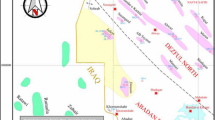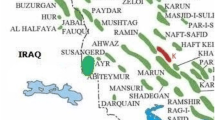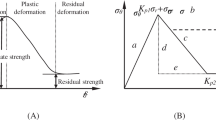Abstract
Drilling slurry has been widely used in the construction of wet-processed borehole excavation, and the stability of such an excavation is of great concern to engineers. In this short note, the problem of borehole stability is revisited using the finite element limit analysis. The study sets out to establish an undrained correlation between stability number and depth ratio of a borehole excavation under axisymmetric condition. To understand several observed phenomena, the effects of slurry pressure and the increasing undrained strength with depth are investigated. The overall aim of the note is to produce practical solutions in the form of design equations for engineer in the field to evaluate the borehole stability using a simple factor of safety.














Similar content being viewed by others
References
Jung C, Ceglarek R, Clauvelin T, Ayeldeen M, Kim D (2020) Deep soil mixing in Sabkha Soils for foundation support in United Arab Emirates. Int J Geosynth Ground Eng 6(1):3
Du Z, Shahin MA, El Naggar H (2021) Design of Ram-compacted bearing base piling foundations by simple numerical modelling approach and artificial intelligence technique. Int J Geosynth Ground Eng 7(2):41
Munaga T, Gonavaram KK (2021) Influence of stratified soil system on behavior of laterally loaded pile groups: an experimental study. Int J Geosynth Ground Eng 7:18
Nash KL, Jones GK (1963) The support of trenches using fluid mud. In: Proceedings of the symposium on grouts and drilling muds in engineering practice. Butterworths, London, pp 177–180
Morgenstern N, Amir-Tahmasseb I (1965) The stability of a slurry trench in cohesionless soils. Géotechnique 15(4):387–395
Filz GM, Adams T, Davidson RR (2004) Stability of long trenches in sand supported by bentonite-water slurry. J Geotech Geoenviron Eng 130(9):915–921
Tsai JS, Chang JC (1996) Three-dimensional stability analysis for slurry-filled trench wall in cohesionless soil. Can Geotech J 33(5):798–808
Fox PJ (2004) Analytical solutions for stability of slurry trench. J Geotech Geoenviron Eng 130(7):749–758
Li YC, Pan Q, Cleall PJ, Chen YM, Ke H (2013) Stability analysis of slurry trenches in similar layered soils. J Geotech Geoenviron Eng 139(12):2104–2109
Zhang F, Gao Y, Leshchinsky D, Zhu D, Lei G (2016) Three-dimensional stability of slurrysupported trenches: end effects. Comput Geotech 74:174–187
Saadi R, Baheddi M, Ferhoune N (2017) Analytical approach of the arching dual effect describing the stability of slurry-wall trenches in cohesionless soil. Int J Geomech 17(10):04017081
Oblozinsky P, Ugai K, Katagiri M, Saitoh K, Ishii T, Masuda T et al (2001) A design method for slurry trench wall stability in sandy ground based on the elastoplastic FEM. Comput Geotech 28(2):145–159
Shalev E, Bauer SJ, Homel MA, Antoun TH, Herbold EB, Vorobiev OY, Levin H, Oren G, Lyakhovsky V (2021) Borehole breakout modeling in arkose and granite rocks. Geomech Geophys Geo-Energy Geo-Resour 7(1):15
Han CY, Wang JH, Xia XH, Chen JJ (2015) Limit analysis for local and overall stability of a slurry trench in cohesive soil. Int J Geomech 15(5):06014026
Zhang J, Gao Y, Zhang F, Wan Y, Liu M (2018) Influence of anisotropy and non- homogeneity on stability analysis of slurry-support trenches. Int J Geomech 18(5):04018028
Qin CB (2019) Determination of slurry density required for stability of slurry-supported trenches excavated in partially submerged soils. Comput Geotech 116:103212
Wang H, Huang M (2020) Upper bound stability analysis of slurry-supported trenches in layered soils. Comput Geotech 122:103554
Sloan SW (2013) Geotechnical stability analysis. Géotechnique 63(7):531–571
Li AJ, Merifield RS, Lin HD, Lyamin AV (2014) Trench stability under bentonite pressure in purely cohesive clay. Int J Geomech 14(1):151–167
Khatri VN, Kumar J (2010) Stability of an unsupported vertical circular excavation in clays under undrained condition. Comput Geotech 37(3):419–424
Kumar J, Chakraborty D (2012) Stability numbers for an unsupported vertical circular excavation in c-f soil. Comput Geotech 39:79–84
Kumar J, Chakraborty M, Sahoo JP (2014) Stability of unsupported vertical circular excavations. J Geotech Geoenviron Eng 140(7):04014028
Keawsawasvong S, Ukritchon B (2017) Stability of unsupported conical excavations in non-homogeneous clays. Comput Geotech 81:125–136
Ukritchon B, Keawsawasvong S (2018) A new design equation for drained stability of conical slopes in cohesive-frictional soils. J Rock Mech Geotech Eng 10(2):358–366
Yodsomjai W, Keawsawasvong S, Thongchom C, Lawongkerd J (2021) Undrained stability of unsupported conical slopes in two-layered clays. Innov Infrastruct Solut 6:15
Yodsomjai W, Keawsawasvong S, Likitlersuang S (2021) Stability of unsupported conical slopes in Hoek-Brown rock masses. Transp Infrastruct Geotech 8:279–295. https://doi.org/10.1007/s40515-020-00137-4
Yodsomjai W, Keawsawasvong S, Senjuntichai T (2021) Undrained stability of unsupported conical slopes in anisotropic clays based on anisotropic undrained shear failure criterion. Transp Infrastruct Geotech. https://doi.org/10.1007/s40515-021-00153-y
Ukritchon B, Keawsawasvong S (2020) Undrained lower bound solutions for end bearing capacity of shallow circular piles in non-homogeneous and anisotropic clays. Int J Numer Anal Meth Geomech 44(5):596–632
Ukritchon B, Keawsawasvong S (2019) Design equations of uplift capacity of circular piles in sands. Appl Ocean Res 90:101844
Ukritchon B, Keawsawasvong S (2018) Undrained lateral capacity of rectangular piles under a general loading direction and full flow mechanism. KSCE J Civ Eng 22(7):2256–2265
Keawsawasvong S, Ukritchon B (2017) Undrained lateral capacity of I-shaped concrete piles. Songklanakarin J Sci Technol 39(6):751–758
Ukritchon B, Keawsawasvong S (2017) Error in Ito and Matsui’s limit equilibrium solution of lateral force on a row of stabilizing piles. J Geotech Geoenviron Eng ASCE 143(9):02817004
Keawsawasvong S, Ukritchon B (2016) Ultimate lateral capacity of two dimensional plane strain rectangular pile in clay. Geomech Eng 11(2):235–251
Yodsomjai W, Keawsawasvong S, Lai VQ (2021) Limit analysis solutions for bearing capacity of ring foundations on rocks using Hoek–Brown failure criterion. Int J Geosynth Ground Eng 7:29
Keawsawasvong S, Lai VQ (2021) End bearing capacity factor for annular foundations embedded in clay considering the effect of the adhesion factor. Int J Geosynth Ground Eng 7:15
Shiau J, Pather S, Ayers R (2006) Developing physical models for geotechnical teaching and research. In: Proceedings of 6th IC physical modelling in geotechnics, pp 157–162
Shiau J, Sams M, Lamb B (2016) Introducing advanced topics in geotechnical engineering teaching—tunnel modelling. Int J GEOMATE 10(1):1698–1705
Shiau J, Lamb B, Sams M (2016) The use of sinkhole models in advanced geotechnical engineering teaching. Int J GEOMATE 10(2):1718–1724
Shiau J, Hassan MM (2020) Undrained stability of active and passive trapdoors. Geotech Res 7(1):40–48
Shiau J, Al-Asadi F (2020) Determination of critical tunnel heading pressures using stability factors. Comput Geotech 119:103345
Shiau J, Al-Asadi F (2020) Two-dimensional tunnel heading stability factors Fc, Fs and Fr. Tunn Underground Space Technol 97: https://doi.org/10.1016/j.tust.2020.103293
Shiau J, Al-Asadi F (2020) Three-dimensional analysis of circular tunnel headings using Broms and Bennermarks’ original stability number. Int J Geomech 20(7):06020015
Butterfield R (1999) Dimensional analysis for geotechnical engineers. Géotechnique 49(3):357–366
OptumCE 2019, OptumG2. Copenhagen, Denmark: Optum Computational Engineering. See https://www.optumce.com/. Accessed 10 Aug 2019
Ciria H, Peraire J, Bonet J (2008) Mesh adaptive computation of upper and lower bounds in limit analysis. Int J Numer Methods Eng 75:899–944
Sauer T (2014) Numerical analysis. Pearson Education Limited, London
Thasnanipan N, Aye Z, Submaneewong C, Teparaksa W (2002) Performance of wet-process bored piles constructed with polymer-based slurry in Bangkok subsoil. Int Deep Found Congr 143–157. https://doi.org/10.1061/40601(256)11
Acknowledgements
This research was supported by Thammasat University Research Unit in Structural and Foundation Engineering, Thammasat University.
Author information
Authors and Affiliations
Corresponding author
Additional information
Publisher's Note
Springer Nature remains neutral with regard to jurisdictional claims in published maps and institutional affiliations.
Rights and permissions
About this article
Cite this article
Keawsawasvong, S., Shiau, J. Instability of Boreholes with Slurry. Int. J. of Geosynth. and Ground Eng. 7, 81 (2021). https://doi.org/10.1007/s40891-021-00326-2
Received:
Accepted:
Published:
DOI: https://doi.org/10.1007/s40891-021-00326-2




